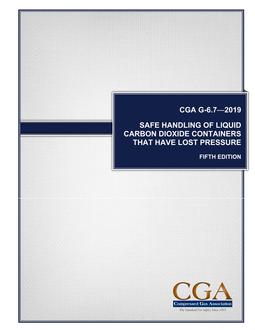CGA G-6.7
Click here to purchase
This publication provides techniques and information that allow owners and operators of bulk carbon dioxide containers to safely repressurize containers that have decreased below their design operating temperatures (typically 200 psig -20 degrees F).
Carbon dioxide auto-refrigerates as gas is removed from a container. This causes the remaining liquid to decrease in temperature until it is colder than the container design limits. Special techniques and considerations need to be used to safely repressurize and warm the dry ice or cold liquid that remains inside a bulk container before returning it to normal service. These procedures are based upon CGA-sponsored testing and the best available technical knowledge.
Improper repressurization of bulk carbon dioxide containers could lead to catastrophic failure due to the extreme cold temperatures of the liquid/solid carbon dioxide making the container walls brittle.
Containers can lose pressure due to a number of upset conditions such as failure of a pressure building vaporizer, failure of a safety relief device to close, excessive liquid or vapor withdrawal.
The 4th edition includes new information on both ASME and EN pressure vessels. It is intended to be internationally harmonized to include typical European pressure vessel limitations and the recently revised ASME code ( 3.5 safety factor vs the older 4).
Product Details
- Edition:
- 4th
- Published:
- 12/23/2009
- Number of Pages:
- 29
- File Size:
- 1 file , 830 KB
CGA G-6.7
Click here to purchase
The scope of CGA G-6.7 is concerned primarily with the safe repressurization of stationary or transportable liquid carbon dioxide containers made of low alloy carbon steels and having a minimum design metal temperature (MDMT) greater than -110 °F (-78.9 °C ).
The purpose of this publication is to provide information to personnel to ensure that carbon dioxide containers that have lost pressure and could contain solid carbon dioxide (dry ice) or liquid carbon dioxide at temperatures less than the MDMT are safely repressurized before being returned to service.
Product Details
- Edition:
- 5
- Published:
- 11/25/2019
- Number of Pages:
- 38
- File Size:
- 1 file , 1.5 MB

